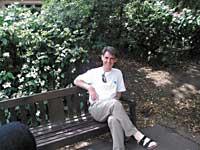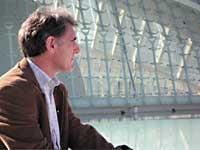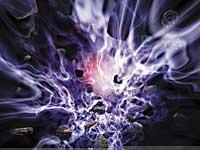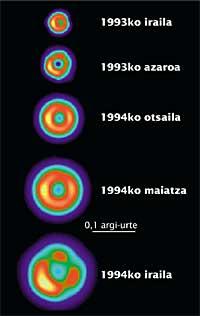Jon Marcaide: I've always had someone willing to pay for my work and research

For me the most difficult thing was to leave Arrasate. I went to study in Zaragoza. Then I went to Madrid and Edinburgh with a scholarship. I have always had the opportunity to work on the best sites and with the best teachers.
In fact, I went to the United States to do other physics things and there I met Professor Irwin Shapiro. That's why I started researching astronomy. I finished the thesis and went to the Max Planck Institute in Bonn, Germany. This institute is a leader in astronomy in Europe, where I have sent many of my students. I was also at the Siemens company in Munich, and then I returned to Spain, to the CSIC, and all as a professor at the University of Valencia.
My career has been long, longer than normal to work in astronomy. I have tried to investigate the issues that have interested me. The truth is that there are many ways to do the curriculum, and this has been mine. I have always had someone willing to pay for my work and research.
How do you think basic research is valued?I think people value the basics as applied science, that is, little. This is due to the lack of scientific culture. In general, they do not understand how research is done in either. They do not understand how products are manufactured from applied research. But basic research has a beauty point that people appreciate.
Astronomy is very attractive. He has had great attention in all societies. Therefore, astronomy has been introduced into many faculties of physics to motivate people to learn physics.
What does an astronomer do in Valencia? There are no big viewpoints...
More or less happened to me. In 1990, there was a chair of Astronomy. I had a position at the CSIC, at the Astrophysics Institute in Granada, and worked with a research team. But I liked Valencia, because it has warm climate and sea. I also wanted to go back to teaching and then went to the University of Valencia. In any case, in Valencia, in Teruel, in Soria or in Vitoria I don't care; I would live in any city.
The type of research I use and the methods of modern astronomy allow me to live anywhere. In short, to investigate new things in astronomy it is essential that you use the resources offered by governments or large institutions, which you can do from wherever you are. I only need a computer and a suitable communications network. When I started it was more difficult, we had to prepare a lot of things on the phone, and that made the work much more expensive.
But for the same reason, my competitors are people from organizations around the world, from Harvard, from Caltech, from Princeton, from organizations in Germany, etc.
What is that way of working?We, starting from an idea, form a proposal. This proposal is judged by two international commissions, one American and one European. If both committees accept the project, the people of both networks agree and give us a certain interferometer time, that is, the possibility of using several telescopes at once. In our case they are radio telescopes distributed all over the world. In fact, we can simultaneously use telescopes ten thousand kilometers away, with synchronism in a microsecond. In addition, we synchronize signals more through computers for interferometry studies.

Our experiments are ready before you start observing them, so once started, only the data remains recorded. It must be said that in our case it is not as correct as in the optical telescope, since we must process the data we record. The first step of this processing can be done in two places, one in the Netherlands and one in New Mexico, in the United States. From there come the images and from them we must begin to interpret the physical phenomena.
Your most important work has been the investigation of a supernova, the explosion of a star. Why is this kind of death interesting?Keep in mind that stars are born quickly in a few million years, then live long, in billions of years, and die in an instant, the heaviest in a few seconds. At birth, the nuclear reactions within the stars are launched and begin to emit light. This process seems very interesting to me, but I don't investigate it because you can't investigate everything. Other astronomers study.
The death of heavy stars is a very substantial phenomenon, since that is when the great chemical elements present in nature are formed, heavier than iron. In addition, the explosion of a star expels much matter and distorts the surrounding space. Among other things, they can collapse molecular clouds and form new stars. Therefore, the death of the stars is a step of a cycle and their understanding serves to understand the process that causes the birth. We also investigate the details prior to the explosion, that is, how the star loses balance and how chemical elements are formed. For the first time we have analyzed how the explosion of a star spreads, which has given us a lot of information about the star that has exploded.
You have also researched quasars...We see the quasars as stars. But we see them because they are far away and we receive them as if they were points. But we know that they are not stars, but bright galaxies of great mass. We have clarified this by analyzing the nearest quasars. These galaxies have a central black hole that devours the stars around them. When this happens, the black hole emits a lot of radiation. We studied part of that radiation, the part of the microwaves.
Quasars not only serve to investigate, but also to navigate the space. The probe that reaches the Titane has been oriented by quasars. He has used quasars as a reference. That is why they are important, especially the radio stations. 90% of quasars are not seen in radiofrequency, but the rest can be considered as a guide for guiding a probe.
Buletina
Bidali zure helbide elektronikoa eta jaso asteroko buletina zure sarrera-ontzian












